The Wurt mound Feddersen Wierde, Land Wursten, district of Cuxhaven
More than 60 years ago, the systematic and large-scale investigations of the Wurt settlement mound Feddersen Wierde, Cuxhaven District, by the then Lower Saxony State Institute for Marsh- and Wurt Research in Wilhelmshaven were to all intents and purposes a venture into new territory. Not only does the Feddersen Wierde represent the first, and to this day the only time that a large village Wurt mound on the southern North Sea coast had been excavated almost in its entirety, but the investigations also comprised numerous scientific investigations aimed at reconstructing the erstwhile environment and economic conditions. For this reason it is certainly justified that these investigations, carried out between 1955 and 1963, are considered to be one of the most important milestones of interdisciplinary settlement research in north-west Europe. The results demonstrate that the Wurt had been established as a low-lying settlement in the 1st century BC, persisting as a Wurt settlement from the 1st century AD into the later Middle Ages, with a hiatus during the late 5th and 6th centuries.
The humid soils of the marshes along the North Sea coast are ideal for the preservation of organic materials for which the excavations of the Feddersen Wierde have provided impressive confirmation. Almost all wooden structures have been preserved, as well as refuse, tools and implements made from bone, antler and other organic materials, as have remains of garments made from wool or leather. Together with ceramic, stone and metal objects which were also recovered in vast numbers, the detailed scientific analysis of this unique and comprehensive finds assemblage has provided numerous new insights about life in this settlement. Furthermore, a large number of objects of Roman origin was recovered during the course of the excavations; they attest to the inhabitants’ extensive contacts into the Roman Empire.
Even though the excavations had been concluded over 60 years ago, the finds assemblage from Feddersen Wierde continues to be analysed using new methods (see bibliography). The subject of the most recent study, the more than 1300 implements of bone and antler, were analysed within the scope of a project funded by the Lower Saxony Ministry for Science and Culture (MWK). The results of the study by K. Struckmeyer were submitted as a doctoral thesis to the University of Hamburg and published as volume 2 of the Studies in Landscape and Settlement History in the Southern North Sea Region (SLSN).
Bibliography
Haarnagel 1979: W. Haarnagel, Die Grabung Feddersen Wierde. Methode, Hausbau, Siedlungs- und Wirtschaftsformen sowie Sozialstruktur. Feddersen Wierde. Die Ergebnisse der Ausgrabung der vorgeschichtlichen Wurt Feddersen Wierde bei Bremerhaven in den Jahren 1955-1963. (Wiesbaden 1979).
Schmid, P., (2006): Die Keramikfunde der Grabung Feddersen Wierde (1. Jh. v. bis 5. Jh. n. Chr.), Probleme der Küstenforschung im südlichen Nordseegebiet 29; Feddersen Wierde 5. Oldenburg.
Schuster, J., 2006: Die Buntmetallfunde der Grabung Feddersen Wierde Chronologie - Chorologie - Technologie. Probleme der Küstenforschung im südlichen Nordseegebiet 30; Feddersen Wierde 6. Oldenburg.
Struckmeyer, K., (2011): Die Knochen- und Geweihgeräte der Feddersen Wierde. Gebrauchsspurenanalysen an Geräten von der Römischen Kaiserzeit bis zum Mittelalter und ethnoarchäologische Vergleiche. Feddersen Wierde 7. Studien zur Landschafts- und Siedlungsgeschichte im südlichen Nordseegebiet 2. Rahden/Westf.



